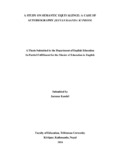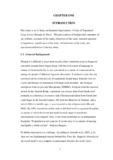Please use this identifier to cite or link to this item:
https://elibrary.tucl.edu.np/handle/123456789/1786| Title: | A Study on Semantic Equivalence: A Case of autobiographyjeevan Kaanda Ki Phool |
| Authors: | Kandel, Jamuna |
| Keywords: | Culture;Equivalent;Language;Translation |
| Issue Date: | 2014 |
| Publisher: | Faculty of Education |
| Abstract: | This research work entitledA Study on Semantic Equivalence: A Case ofAutobiographyJeevan Kaanda KiPhoolwascarried out toanalyze thesemantic equivalenceatsentence level between the source text (henceforth:ST) and translated text (henceforth: TT). The source of data consists of theoriginal Nepali text and its translated English versionJeevanKaanda Ki Phool.The ST and TTweredeemed as simple universe. From this, the selection of thesample size consistedofthirtypairs of sentences from both texts. For sampling,the random sampling methodwasapplied. Only observationwasused as a tool.Syntactic structure and semantic analysiswasused for the data analysis. Itwasfound that the translator has carefully chosen different lexical itemsin TT tofulfill semantic equivalence. Sometimes, the translator himself getsderailedand the work of translation cannot meet the semantic equivalence,Thetranslator has sometimesusedmorelexical item which is not found in ST. Itwasfound that, the translator split the syntactic structure of the compoundsentence intomore thantwo in TT.Itwasalso found that the translator mostlyomitted exclamation mark in TT whereas the ST exclamatory sentences containit. It makes difference in meaning because sometimes same form may havedifferent meaning and vice-versa. This thesis comprisesoffive chapters: chapter one dealswithintroduction,statement of the problem, rationale of the study, objectives of the study,research questions, significance of the study, delimitations of the study andoperational definitions of the key terms. Chapter two dealswiththe review ofrelated literature and conceptual framework, which provides the ideas tobroaden our knowledge base in our research area. Chapter threedepictsthemethods and procedures of the study, it contains research design, field or areasof the study, sampling procedure, data collection tools, procedure and data interpretation procedure. Chapterfourincludes the results anddiscussion/interpretation of data which shows the overall discussion of thecollected data. Chapter fivepresentsthe summary, conclusions andimplications from the whole study. Last part of the thesis comprises thereferencesand appendices. |
| URI: | http://elibrary.tucl.edu.np/handle/123456789/1786 |
| Appears in Collections: | English Language Education |
Files in This Item:
| File | Description | Size | Format | |
|---|---|---|---|---|
| cover.pdf | 31.78 kB | Adobe PDF |  View/Open | |
| CHAPTER.pdf | 208.43 kB | Adobe PDF |  View/Open |
Items in DSpace are protected by copyright, with all rights reserved, unless otherwise indicated.
